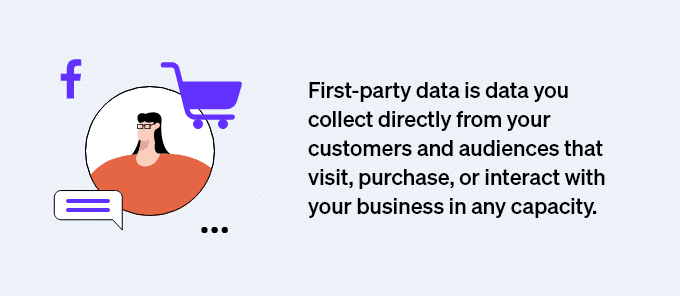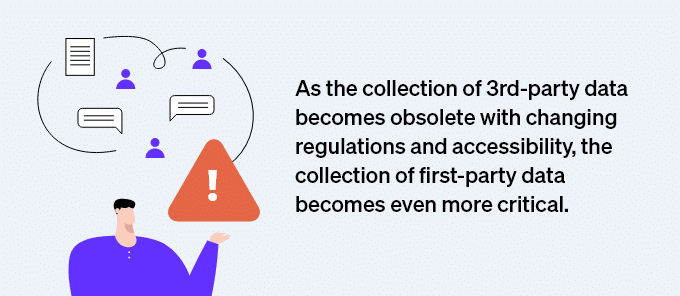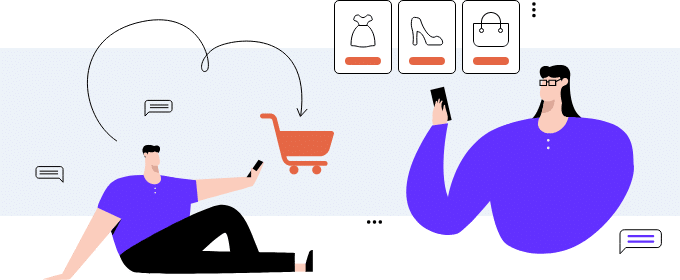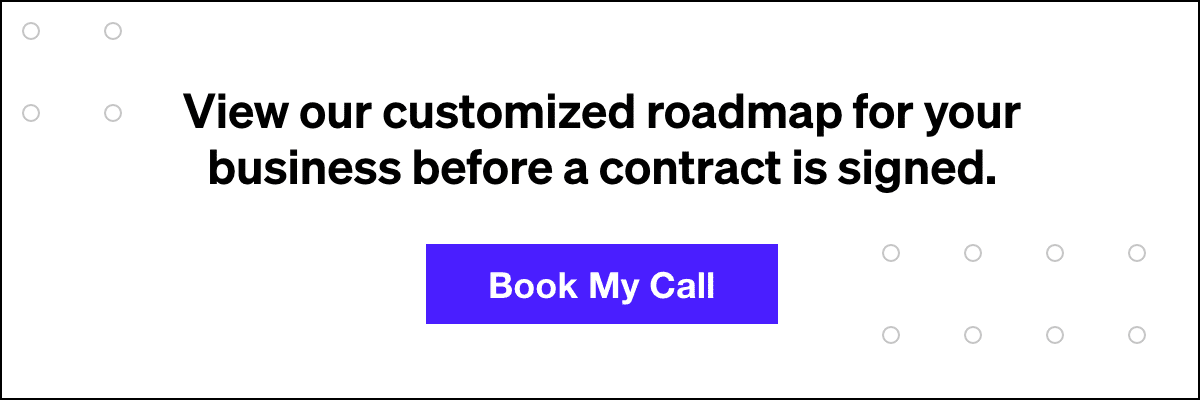What Is First-Party Data and Why RIGHT NOW Is the Time to Have a Clear Strategy

In 2021, one of the biggest topics amongst marketers and business owners is first-party data (also referred to as customer data). In a world in which Google and Apple have declared changes that will rock “3rd party” data collection, deprecating the use of cookies and limiting the tracking many have used for so long, the collection and appliance of first-party data has never been more crucial. To put it simply, if you do not have a clear strategy in place you are already falling behind…

The discussion has been looming – but industries and businesses of all kinds NEED to change and evolve their strategies with data collection in 2021 as these changes come about. Keep reading for must-know insight highlighting the concept of first-party data, how to properly collect it, and how it will not only solve business issues but expand the ability for businesses to target and connect with their ideal customer profiles.
What is First-Party Data?

First-party data is data you collect directly from your customers and audiences that visit, purchase, or interact with your business in any capacity. It’s the most accurate data you can collect and provides more value to you and your customers as it constantly grows and develops as soon as collection starts. This helps to tailor experiences, products and services, and targeting.
First-party data includes but is not limited to:
- Contact information (email, phone number, etc.)
- Demographics
- Visited websites & interactions – what is most interesting to them and what they are most engaged with
- Purchase History – what are they buying and what should they be buying next
- Behaviors – peak times of the year, times of day, days of the week, etc.
- Time spent on the website – how they shop, research, and make buying decisions
And much more, these are just some of the basics but you can understand how valuable this information can be to your business’s growth if collected and harnessed in a strategic and actionable way.
First-party data is available to all businesses, but most do not currently take advantage of their data warehouses due to a lack of know-how or lack of proper data collection practices or strategies. Most businesses currently heavily leverage and make decisions off of 3rd-party data they collect through various platforms that aggregate data into larger data sets.
As the collection of 3rd-party data becomes obsolete with changing regulations and accessibility, the collection of first-party data becomes even more critical.

Why is First-party Data Important & How Can You Use it to Fuel Growth?
First-party data allows for marketers and business owners to analyze their customer base’s demographics, values, direct behavior, and overall interests. You can begin to personalize your actions to your customer’s profile, a tactic that has proven to be more successful the more you can get the profile correct. A few business metrics it impacts include conversion rate (huge to drive profitable customer acquisition), advocacy, brand affinity, shopping experience satisfaction, and many more.
For ad platforms, first-party data has opened a lot of doors to new possibilities. By obtaining first-party data and analyzing it, you can then leverage it within campaigns to improve relevance scores with audiences, attain better match rates, and strengthen their returning customer base. See more on my article on DataQ’s blog here.
Facebook and Google both offer options for utilizing first-party data in this ever-changing landscape:
- Facebook Custom Audiences: You can create customer lists based on first-party data. When uploading a new list, Facebook then applies “matches” from your data to Facebook profiles, meaning the more accurate and direct your data is, the higher your match rates will be.
- Google Customer Match: A similar idea here, Google allows users to use first-party data to match with customers across Search, Shopping, Gmail, YouTube, and Display advertising. Any profiles matched then filter into your Customer Match audience.
Aside from advertising and the impending changes within tracking users across browsers, first-party data is important for the evolution of how we interact with customers and position businesses in general. The importance of data security, privacy, and governance has never been more important, as first-party data will be the driving force of data-driven marketing moving forward.
Here are the top ways in which first-party data is used effectively:
- Gain Insights on Audiences
- Having more understanding of your customers allows you to turn data into action – with accuracy. Capturing multiple data points means capturing different traits, then turning your aggregate customer base into a profile, allowing you to then target existing customers and new alike by customizing content, products, services, and more.
- EXAMPLE: An online ice cream delivery service recently adopted a DMP strategy and has been collecting data for over a year. Through their DMP they can now string customer traits together based on their demographics, region, behaviors, and more. Through doing so, they now have identified a “top buyers” audience based on users who have bought more than 3 times from their shop at consistent times.

- Personalize and Pinpoint Customers for Marketing Campaigns
- Applying your first-party data-born audience segments to your marketing campaigns is the quintessential action all businesses should take away from this article. DataQ does this by creating audiences from your customer data, then allowing you to quickly apply those “effective” audiences to your Facebook and email campaigns, resulting in a higher conversion rate. First-party data allows this tool and you to gather insights then execute at a new level.
- EXAMPLE: Shoe Company X captures first-party data from their customers including their shoe size. The business notices that the majority of their business is successful with male customers who have a shoe size equivalent or higher than size 12. This information allows the business to tailor its core proposition to larger footed customers, capitalizing on a historically successful customer audience.
- Retarget Existing Customers and Nurture to Drive Lifetime Value & Repeat Purchases or Sell them Adjacent Complementary Products your Brand Offers
- What do you do when users visit but don’t convert? Retargeting is one of the most common campaigns marketers run, but how can you be more effective? First-party data can be captured on these first visits (like product interest, page interest, etc.) and be applied to retargeting, resulting in a more successful second touch for brands.
- EXAMPLE: Baby Brand Y has successfully increased their traffic YoY, but the conversion rate has inversely been affected. They begin to analyze their data and deploy new audiences into retargeting campaigns to users who have not yet purchased but have visited the site. They display products they know these users have shown interest in within their retargeting ads and direct content to them to help educate them, resulting in a higher conversion rate.

- Predict Customer Behavior and Interests
- First-party data allows you to begin creating a customer profile based on aggregate properties within your warehouse. This profile is not just for retroactive use, but more to predict the type of user profile more likely to buy or convert with you. You can begin to predict what actions certain users will take from the content you serve them, and tailor the entire experience based on the original profile deducted.
- EXAMPLE: Candle Company Z uses its first-party data to create a customer profile. This profile is historically a 25 to 30-year-old female in California, buying typically in the holiday season in the evening time, using an iPhone. Candle Company Z then directs its marketing strategy to specifically target and fit this profile.
What’s the First Step? Proper First-party Data Collection.
Data from your customers can come in very many different forms. You can collect data through your eCommerce storefront, your CRM, surveys, and so on. The most common way to collect and aggregate this data is through a DMP – or Data Management Platform. There are many options for DMPs, but the simplest way to think about it is a platform that collects information, digests it, analyzes the data, then disperses it in a way that is effective for the end-user, business, or marketer.

By using a DMP you can begin to collect data and create audience segments, similar to what we do with our DataQ product and eCommerce businesses. Applying these newly created audiences or customer segments to your marketing campaigns, emails, and offline efforts, you will see an increase in accuracy and success with each step.

In Conclusion
While the world still reacts to how collecting data changes and is limited (well, limited in the old methods), the collection of first-party data has never been more important. The way we interact with our customers will be more protected, more enjoyable, and more effective as a marketer or business owner. The methods above are only the first step, while the possibilities of first-party data are endless.
Check out our first-party data collection and analysis platform DataQ. If you have a Shopify, Magento, or eCommerce store in general, it’s as easy as one-click integration to setup. From there you can begin building your audiences and applying them to your campaigns. Sign up for a free trial here.
Our Editorial Standards
Reviewed for Accuracy
Every piece is fact-checked for precision.
Up-to-Date Research
We reflect the latest trends and insights.
Credible References
Backed by trusted industry sources.
Actionable & Insight-Driven
Strategic takeaways for real results.


















